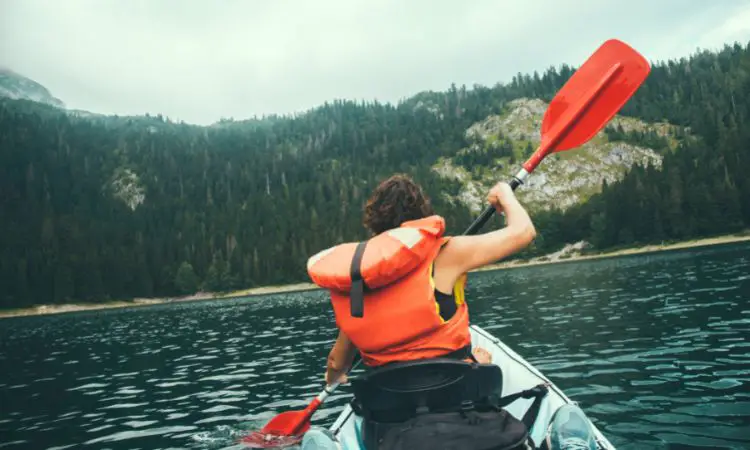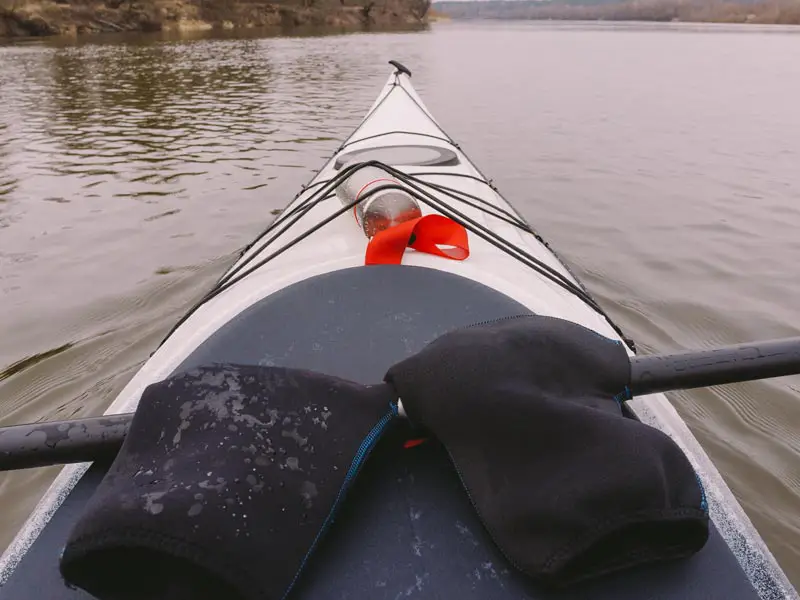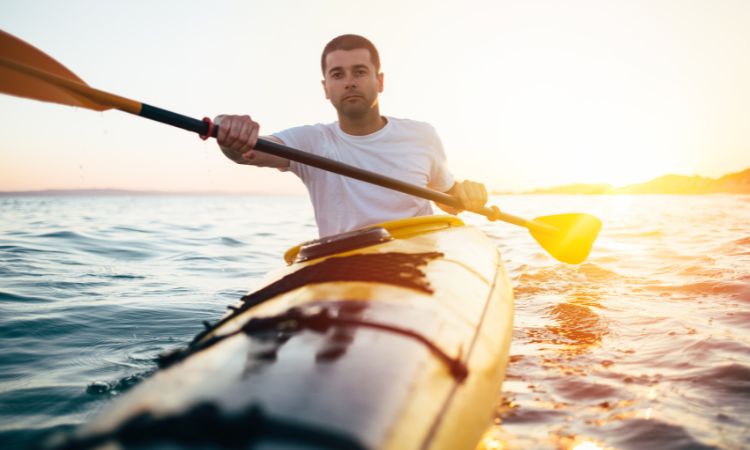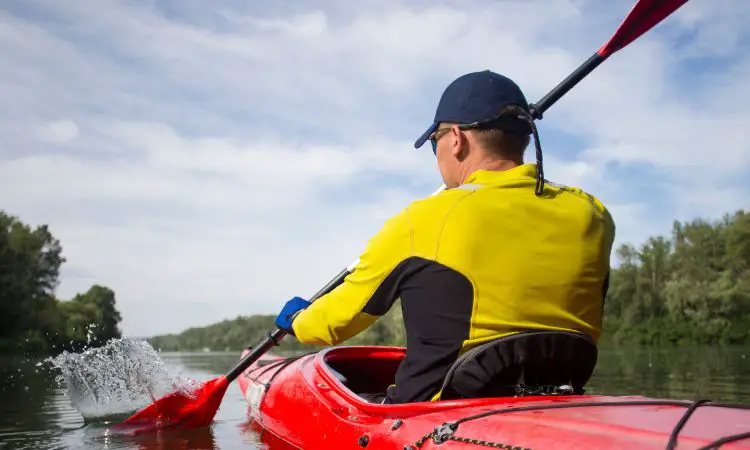A solid rule of thumb to follow when determining what to wear is to dress in layers. If you get too warm, you can simply shed a layer and save it for the chilly weather. So, what to wear when kayaking? It’s important to dress for the water temperature, as well as the ambient air temperature, to make for a safe and pleasant kayaking experience.
Outfitting As A Beginner Kayaker:
If you are just starting out kayaking, you don’t need to splash out and buy all the most expensive gear right away. Wear whatever you have handy that will help to keep you protected from the elements. Once you get more into the sport, then you can invest in some kayak-specific gear.
An ideal kayaking outfit includes a dry suit or wetsuit, but if you’re just starting out, you can get by with clothes from around the house. Wear water-appropriate clothing that will be comfortable If you end up in the water.
That being said, this only applies to warm-weather kayaking. If you are kayaking in the winter seasons, you will need to invest in a wetsuit or drysuit as a matter of safety.
The Essentials For Kayaking
Always Use a PFD When Kayaking
The increased buoyancy provided by a personal flotation device (PFD) is an invaluable aid when you need to remain floating in the water. Every paddler, whether in a kayak, canoe, or SUP, should always have a personal flotation device on hand, and in some cases, this will be a legal requirement.
Although the names are often used interchangeably, PFDs, life jackets, and life vests aren’t the same thing. They will all help you float if you end up in the water, but a life jacket, or type 1 life jacket to be exact, will float an unconscious person with their face out of the water.
That being said, most kayakers opt for a less restrictive PFD, usually a buoyancy aid, that is designed to help keep them afloat while conscious. It makes no difference if you’re a great swimmer. Make sure you always wear a PFD when kayaking.
Spray Skirts, What Are They?
A spray skirt is a fabric lid that goes around the waist of the kayaker and seals the cockpit of a kayak to keep water and the elements out. They are essential when paddling in white water but can add a serious amount of extra comfort when paddling on flat water as they keep your legs dry from the rain or just splashes of water.
The majority of spray skirts are fashioned from nylon or neoprene. Nylon skirts are fine for flat water use since they provide more airflow than neoprene but aren’t as watertight as the latter material.
Neoprene spray skirts are the best option if you’re looking for something that will keep you dry in higher waves and toasty in cooler weather. If you can afford it and wish to paddle in all seasons, you can purchase both. There are also skirts that combine neoprene for insulation and greater weather protection) and nylon (for comfort and breathability) (for ventilation). These hybrids are great for transitional circumstances but not for extremes like high surf or freezing temperatures.
Shoes
Even though you spend most of the time sitting down when kayaking, shoes are still a vital piece of kayaking equipment. In winter, they will stop your feet from freezing, and in summer, they will still be needed for launching and recovering your kayak.
It’s possible that you already own a pair of water sandals or shoes that will work fine for kayaking. The best shoes for walking on the shore and transporting your boat to and from the water dry fast and offer adequate foot protection. In order to safeguard your feet and prevent slips on wet rocks, I advise you to wear footwear with a thick sole and good tread. If you decide to wear sandals, make sure they have a heel strap that secures them to your feet, so they don’t slip off while swimming.
Even if you like to go shoeless while paddling, you should bring a pair of sandals along. Paddlers should wear fleece, wool, or neoprene socks with their water shoes while venturing out in the winter. When it comes to keeping your feet warm when wet, neoprene boots are unrivaled.
What To Wear When Kayaking

Many paddlers choose to paddle in a swimsuit as their initial layer of protection when the weather is warm and the trip length is short. Just keep the following suggestions in mind, and you should be OK for the remainder of your vacation. As an alternative, you should wear outdoor-appropriate sports bras and underwear made of materials other than cotton.
Base Layer Tops
Rashguards, often constructed from polyester or nylon combined with Lycra® spandex, are excellent for paddling and other water activities because of their high UPF ratings, rapid drying times, and excellent stretch and mobility. Additionally, you may wear them comfortably beneath a wetsuit or other layers because of their formfitting style and flat-seam construction. Base layers made of synthetic materials or wool are acceptable alternatives.
Mid-layer
Layering is key, this allows you to add or remove layers as you get hotter or colder. Choose thin fleece or similar synthetic fibers as your mid-layers that will be breathable and moisture-wicking.
Bottoms
For your lower half, you can choose between wearing board shorts or comfy quick-dry pants. Avoid wearing anything that can restrict your movement or cause irritation. You shouldn’t wear super thin fabrics like those seen in some polyester yoga pants since they won’t hold up to the frequent movement in your seat that comes with paddling.
Surface layer
Invest in a high-quality raincoat and matching pants if rain is in the forecast. Gaskets around the wrists and neck of a paddling jacket keep water out, which is especially useful for preventing the drips that flow down the paddle shaft. If you’re merely heading out for the day and the weather forecast doesn’t call for any serious precipitation, still pack a jacket that can keep you dry and comfortable in light rain. You may not need to wear it, but it’s always best to be prepared.
Footwear
The toes and soles of the feet are best protected by a pair of Neoprene paddling booties, which are also lightweight, water-ready, and functional. Basically, any shoes that can perform this will do. Water sandals, on the other hand, won’t offer the same level of protection as booties and may end up collecting gravel, sand, and mud when you enter and exit the water. To prevent your feet from slipping off, it’s best to stay away from shoes that don’t have a back strap, such as flip-flops.
Waterproof socks and paddling booties are available for use in colder climates and in areas where rain or wave splash is common. As an alternative, you can wear thick socks that are not made of cotton under your booties to keep you warm.
Hats
Try to find caps or hats with extra-wide brims. If you don’t have a chin strap or another secure method of keeping your hat on your head, a cap leash is another option to consider. If you’re going to be outside in the cold, you should also wear a beanie, which should layer comfortably under or on top of your other hat.
If you are white water kayaking or expecting to get your head wet, then you can use a neoprene hood instead of a hat. They will still provide insulation even when wet.
Gloves
The blisters and cold wind are two of the many reasons why paddling gloves are useful. There are also attachments called “Pogies” that may be attached to the paddle so that the user can slip their hands inside and better grip the shaft on chilly days. Some people find that pogies are the best option since they allow a more secure hold on the paddle and protection from the weather for the wearer’s hands.

Sunglasses With Straps
Being out on the water on a sunny day will subject you to a lot of glare from the surface of the water. Not only is this uncomfortable, making you squint to be able to see, but over time, it can cause permanent, irreparable damage to your eyes. Make sure you wear good polarized sunglasses on sunny days when kayaking.
Losing an expensive pair of sunglasses at the water is one of life’s most heartbreaking moments. Make sure your retainer floats and stays attached at all times.
What To Wear When Kayaking In Summer?

Dressing for kayaking is simple if you live in a warm climate or plan to conduct most of your paddling in the hot summer months when the water is warm. Kayaking just necessitates a bathing suit, bikini, or “tankini,” a sturdy pair of water shorts to prevent chafing, and, for added convenience, perhaps a quick-dry t-shirt.
Wearing a light, long-sleeved, quick-drying shirt or rash vest helps shield your skin from the sun without sacrificing your comfort. Wearing a hat, sunglasses, and sunscreen is also recommended.
What To Wear Kayaking In The Winter

Paddling in the winter requires extra clothing. Keep in mind that your layers should be comprised of moisture-wicking materials (so no cotton!) Base layers from reputable brands are always manufactured from high-quality materials like wool, polypro, or fleece, even if those brands’ characteristic fabrics are different.
Invest in a quality pair of long underwear that you may wear underneath other garments. You can also find windproof layers that are lined with fleece. Even if any of your layers get wet, you’ll still be able to stay somewhat toasty. Wearing a wetsuit vest or neoprene “farmer John/Jane” underneath your other layers can keep you warm without restricting your mobility in the arms and shoulders.
Put on an outer layer that will keep the wind at bay. There are a variety of options, from just donning a raincoat to investing in a dedicated paddling jacket and leggings. These are constructed from wind-resistant material that traps body heat from lower layers. It’s possible to assemble your own outer layer with a large selection of elements that range from basic to high-performance. For prolonged use in cold water or weather, some paddles come with latex gaskets around the wrists, neck, and ankles.
Wetsuit Or Drysuit For Kayaking In The Winter?
When kayaking in the winter, you are going to want to wear either a wetsuit or a drysuit. Both will keep you warm if you accidentally capsize, but do this in completely different ways.
What Is A Drysuit?
As the name suggests, a drysuit will keep you dry. They are made from completely waterproof material and have tight-fitting rubber gaskets around your wrists and neck, and often have waterproof boots fixed at the end of the legs.
Many people find drysuits restrictive, and the fact they are waterproof makes them far less breathable; added to that, the fact that clothes have to be worn underneath the drysuit makes it difficult to remove layers if you start to get hot.
What Is A Wetsuit?
A wetsuit, on the other hand, is made from neoprene and allows water through, getting you wet. The water gets trapped close to your skin and provides an insulating layer that keeps you warm. They are far more breathable and are worn as a base layer, allowing waterproofs to be worn over the top.
How To Know Which One To Use
Although it often comes down to personal preference, it is the water temperature that should be your deciding factor of whether to choose between a wetsuit or drysuit. If the water temperature is below 45 degrees, you should wear a drysuit instead of a wetsuit. Once the water temperature gets this cold, capsizing unexpectedly can cause a shock to the body that can be deadly. A wetsuit will not prevent this, but a drysuit will.
Also Check: Are Kayaks Dangerous? – Staying Safe On The Water
FAQ’s
Do you wear a bathing suit to a kayak?
There are many paddlers who choose to wear only a swimsuit while venturing out for short periods of time in warm weather.
What are the best shoes to wear while kayaking?
When going kayaking, it’s best to wear water booties or water shoes. They will keep the rocks out, keep your feet toasty, and keep you on your feet. You can also wear water sandals with the right straps, but your feet might get cold if the water is chilly.

